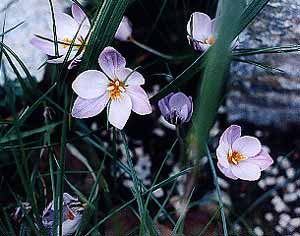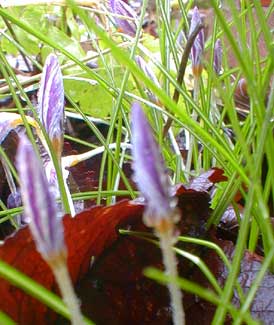
'Fontenay'
Winter Crocus
"Crocus twined round your young neck."
-Sappho
Crocus laevigatus var fontenayi or Fontenay Winter Crocus is an old gardened form with lilac flowers. Their first year in the ground, the striped buds of this crocus popped up by late December & by the end of the first week of January were blooming gung-ho amidst their own thread-thin grass. Their second year they were in full bloom earlier, flowering at mid-December.
If you get on your knees to sniff the blooms, they have a scent of honey.
The photo above left was taken January 10 of their first year. On the insides, the blooms are a deep lilac with yellow feathery bits. The exterior sides of the petals are alternatingly buffed paler violet & darkly purple-striped petals.
 When the sun is fading in the afternoon, they close their flowers not to reopen until the sun reaches them the next morning, though on a very overcast day they will remain closed the whole day. This means that the striped exterior of the petals, while folded, is visible for all or part of each day. They will continue blooming a whole month if no heav rains beat them up.
When the sun is fading in the afternoon, they close their flowers not to reopen until the sun reaches them the next morning, though on a very overcast day they will remain closed the whole day. This means that the striped exterior of the petals, while folded, is visible for all or part of each day. They will continue blooming a whole month if no heav rains beat them up.Our temperate zone 8 suits this winter crocus well. They can be planted down to Zone 6 with success but will need a protected area, being native of Crete & Greece & not liking to get too awfully cold nor too warm. It likes to be planted in maximum sunshine, though ours has done well with only partial sunlight through the winter-naked deciduous tree limbs.
Because they are smaller than most crocuses, they can get lost in groundcover, so are best placed at the front of a garden & not in turf. The little first-year patch, as shown in the 2002 photo above, was a conservative planting of only six small hazelnut-like corms, & they were already providing well over a half-dozen blooms the following year.
Two years later, in autumn 2004, their part of the garden had to be torn up & I made a careful effort to recover the corms to replant in a new raised garden's ledge. Quite a number of extremely tiny cormlets were uncovered, but they were so small I could not possibly have found them all.
When the corms & cormlets I recovered were moved to their new location, I added five more corms to slightly enlarge the colony. The following mid-December they were in larger bud than ever, but winter of 2005/2006 was unusually wet & perpetually overcast, so they were rarely opened. The buds themselves, however, were quite beautiful, & lasted longer than they would if opened every day. The second photo shows the December blooms closed & still bud-like, strikingly striped on the outside.
The mature brown pointed corms are half the size of hazel nuts & really do look rather hard like a nut. The name laevigatusalludes to the polished nutlike surface of the corm. These naturalize easily & can be expected to return every year pretty much forever.
Two other of our crocuses are reliable winter bloomers for our region, flowering January some years, December others; both are bright yellows: C. ancyrensis 'Golden Bunch' & C. korolowii 'Mountain Glory.'